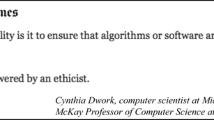Abstract
In recent years, there has been a surge in research addressing the question which properties predictive algorithms ought to satisfy in order to be considered fair. Three of the most widely discussed criteria of fairness are the criteria called equalized odds, predictive parity, and counterfactual fairness. In this paper, I will present a new impossibility result involving these three criteria of algorithmic fairness. In particular, I will argue that there are realistic circumstances under which any predictive algorithm that satisfies counterfactual fairness will violate both other fairness criteria, that is, equalized odds and predictive parity. As will be shown, this impossibility result forces us to give up one of four intuitively plausible assumptions about algorithmic fairness. I will explain and motivate each of the four assumptions and discuss which of them can plausibly be given up in order to circumvent the impossibility.




Similar content being viewed by others
Availability of Data and Material
Not applicable.
Notes
This is because after the intervention on S, L is screened off from \(U_2\).
For a discussion and defense of the two assumptions, see Pearl (2009, pp. 61–64) and Zhang and Spirtes (2016). Note, that some authors occassionally use an assumption weaker than faithfulness, namely causal minimality (Zhang and Spirtes, 2011) The argument in this paper, however, relies on inferential steps in both directions: from (conditional) independencies to properties of the causal graph, as well as from properties of the causal graph to (conditional) indepenencies. The minimality condition alone would not suffice to allow for these steps under all possible probabilistic parameters in the causal model (if, say, the effect of one causal path were to exactly undo the effect along another one in terms of a change in the probability distribution).
See, e.g., Title VII of the Civil Rights Act of 1964, the Age Discrimination in Employment Act of 1967, the Rehabilitation Act of 1973, and the Americans with Disabilities Act of 1990.
References
Beigang, F. (2023). Reconciling Algorithmic fairness criteria. Philosophy & Public Affairs.
Celis, L.E., Huang, L., Keswani, V., & Vishnoi, N.K. (2019). Classification with fairness constraints: A meta-algorithm with provable guarantees. In Proceedings of the conference on fairness, accountability, and transparency (pp. 319–328).
Chiappa, S. (2019). Path-specific counterfactual fairness. In Proceedings of the AAAI Conference on Artificial Intelligence (vol. 33, no. 01, pp. 7801–7808).
Chouldechova, A. (2017). Fair prediction with disparate impact: A study of bias in recidivism prediction instruments. Big Data, 5(2), 153–163.
Eidelson, B. (2015). Discrimination and disrespect. Oxford University Press.
Eva, B. (2022). Algorithmic fairness and base rate tracking. Philosophy & Public Affairs, 50, 239–266.
Flew, A. (1993). Three concepts of racism. International Social Science Review, 68(3), 99.
Halldenius, L. (2017). Discrimination and irrelevance.
Hardt, M., Price, E., & Srebro, N. (2016). Equality of opportunity in supervised learning. Advances in Neural Information Processing Systems, 29, 3315–3323.
Hedden, B. (2021). On statistical criteria of algorithmic fairness. Philosophy & Public Affairs, 49, 209–231.
Hellman, D. (2019). Measuring Algorithmic Fairness. In Virginia Public Law and Legal Theory Research Paper No. 2019–39, Virginia Law and Economics Research Paper No. 2019–15, Virginia Law Review, Forthcoming.
Kilbertus, N., Rojas-Carulla, M., Parascandolo, G., Hardt, M., Janzing, D., & Schölkopf, B. (2017). Avoiding discrimination through causal reasoning. arXiv:1706.02744.
Kilbertus, N., Ball, P.J., Kusner, M.J., Weller, A., & Silva, R. (2020). The sensitivity of counterfactual fairness to unmeasured confounding. In Uncertainty in Artificial Intelligence (pp. 616–626). PMLR.
Kleinberg, J., Mullainathan, S., & Raghavan, M. (2016). Inherent trade-offs in the fair determination of risk scores.
Kusner, M.J., Loftus, J.R., Russell, C., & Silva, R. (2017). Counterfactual fairness. In Proceedings of the 31st International Conference on Neural Information Processing Systems (NIPS’17) (pp. 4069–4079). Curran Associates Inc.
Lippert-Rasmussen, K. (2014). Born free and equal?: A philosophical inquiry into the nature of discrimination. Oxford University Press.
Loftus, J. R., Russell, C., Kusner, M. J., & Silva, R. (2018). Causal reasoning for algorithmic fairness. arXiv:1805.05859.
Moreau, S. (2010). What is discrimination? (pp. 143–179). Philosophy & Public Affairs.
Pearl, J. (2009). Causality. Cambridge University Press.
Pleiss, G., Raghavan, M., Wu, F., Kleinberg, J., & Weinberger, K.Q. (2017). On fairness and calibration. Advances in Neural Information Processing Systems, 30.
Russell, C., Kusner, M., Loftus, J., & Silva, R. (2017). When worlds collide: integrating different counterfactual assumptions in fairness. In Advances in Neural Information Processing Systems (pp. 6414–6423).
Verma, T. (1993). Graphical aspects of causal models. Technical Report R-191, UCLA.
Wu, Y., Zhang, L., & Wu, X. (2019). Counterfactual fairness: Unidentification, Bound and Algorithm. In IJCAI (pp. 1438–1444).
Zhang, J., & Spirtes, P. (2016). The three faces of faithfulness. Synthese, 193(4), 1011–1027.
Zhang, J., & Spirtes, P. (2011). Intervention, determinism, and the causal minimality condition. Synthese, 182, 335–347.
Funding
The author declares that no funds, grants, or other support were received during the preparation of this manuscript.
Author information
Authors and Affiliations
Corresponding author
Ethics declarations
Conflict of Interest
The author has no relevant financial or non-financial interests to disclose.
Ethics Approval and Consent to Participate
Not applicable.
Consent for Publication
Not applicable.
Additional information
Publisher's Note
Springer Nature remains neutral with regard to jurisdictional claims in published maps and institutional affiliations.
Rights and permissions
Springer Nature or its licensor (e.g. a society or other partner) holds exclusive rights to this article under a publishing agreement with the author(s) or other rightsholder(s); author self-archiving of the accepted manuscript version of this article is solely governed by the terms of such publishing agreement and applicable law.
About this article
Cite this article
Beigang, F. Yet Another Impossibility Theorem in Algorithmic Fairness. Minds & Machines 33, 715–735 (2023). https://doi.org/10.1007/s11023-023-09645-x
Received:
Accepted:
Published:
Issue Date:
DOI: https://doi.org/10.1007/s11023-023-09645-x




